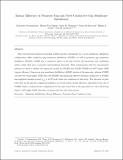| dc.contributor.author | AlMarzooqi, Faisal A. | |
| dc.contributor.author | Arafat, Hassan A. | |
| dc.contributor.author | Swaminathan, Jaichander | |
| dc.contributor.author | Chung, Hyung Won | |
| dc.contributor.author | Warsinger, David Elan Martin | |
| dc.contributor.author | Lienhard, John H | |
| dc.date.accessioned | 2016-11-18T23:13:03Z | |
| dc.date.available | 2016-11-18T23:13:03Z | |
| dc.date.issued | 2015-12 | |
| dc.date.submitted | 2015-10 | |
| dc.identifier.issn | 03767388 | |
| dc.identifier.uri | http://hdl.handle.net/1721.1/105372 | |
| dc.description.abstract | This work presents numerical modeling results and flux experiments for a novel membrane distillation configuration called conductive gap membrane distillation (CGMD), as well as permeate gap membrane distillation (PGMD). CGMD has a conductive spacer in the gap between the membrane and condensing surface rather than more commonly used insulating materials. Flux measurements with two experimental systems are used to validate the numerical models for PGMD and CGMD. PGMD has 20% higher GOR (energy efficiency) than an air gap membrane distillation (AGMD) system of the same size, whereas CGMD can have two times higher GOR than even PGMD. Increasing gap effective thermal conductivity in CGMD has negligible benefits beyond View the MathML source under the conditions of this study. The direction of pure water flow in the gap has a significant influence on overall system energy efficiency, especially in the case of CGMD. Using a countercurrent configuration for the pure water flow in the gap relative to the cold stream leads to 40% higher GOR than flow cocurrent with the cold water stream. | en_US |
| dc.description.sponsorship | MIT & Masdar Institute Cooperative Program (Reference no. 02/MI/MI/CP/11/07633/ GEN/G/00) | en_US |
| dc.language.iso | en_US | |
| dc.publisher | Elsevier | en_US |
| dc.relation.isversionof | http://dx.doi.org/10.1016/j.memsci.2015.12.017 | en_US |
| dc.rights | Creative Commons Attribution-Noncommercial-Share Alike | en_US |
| dc.rights.uri | http://creativecommons.org/licenses/by-nc-sa/4.0/ | en_US |
| dc.source | Prof. Lienhard via Angie Locknar | en_US |
| dc.title | Energy efficiency of permeate gap and novel conductive gap membrane distillation | en_US |
| dc.type | Article | en_US |
| dc.identifier.citation | Swaminathan, Jaichander, Hyung Won Chung, David M. Warsinger, Faisal A. AlMarzooqi, Hassan A. Arafat, and John H. Lienhard V. “Energy Efficiency of Permeate Gap and Novel Conductive Gap Membrane Distillation.” Journal of Membrane Science 502 (March 2016): 171–178. | en_US |
| dc.contributor.department | Massachusetts Institute of Technology. Department of Mechanical Engineering | en_US |
| dc.contributor.department | Rohsenow Kendall Heat Transfer Laboratory (Massachusetts Institute of Technology) | en_US |
| dc.contributor.approver | Lienhard, John H. | en_US |
| dc.contributor.mitauthor | Lienhard, John H | |
| dc.contributor.mitauthor | Swaminathan, Jaichander | |
| dc.contributor.mitauthor | Chung, Hyung Won | |
| dc.contributor.mitauthor | Warsinger, David Elan Martin | |
| dc.relation.journal | Journal of Membrane Science | en_US |
| dc.eprint.version | Author's final manuscript | en_US |
| dc.type.uri | http://purl.org/eprint/type/JournalArticle | en_US |
| eprint.status | http://purl.org/eprint/status/PeerReviewed | en_US |
| dspace.orderedauthors | Swaminathan, Jaichander; Chung, Hyung Won; Warsinger, David M.; AlMarzooqi, Faisal A.; Arafat, Hassan A.; Lienhard V, John H. | en_US |
| dspace.embargo.terms | N | en_US |
| dc.identifier.orcid | https://orcid.org/0000-0002-2901-0638 | |
| dc.identifier.orcid | https://orcid.org/0000-0001-8375-2694 | |
| dc.identifier.orcid | https://orcid.org/0000-0003-3446-1473 | |
| dspace.mitauthor.error | true | |
| mit.license | OPEN_ACCESS_POLICY | en_US |
